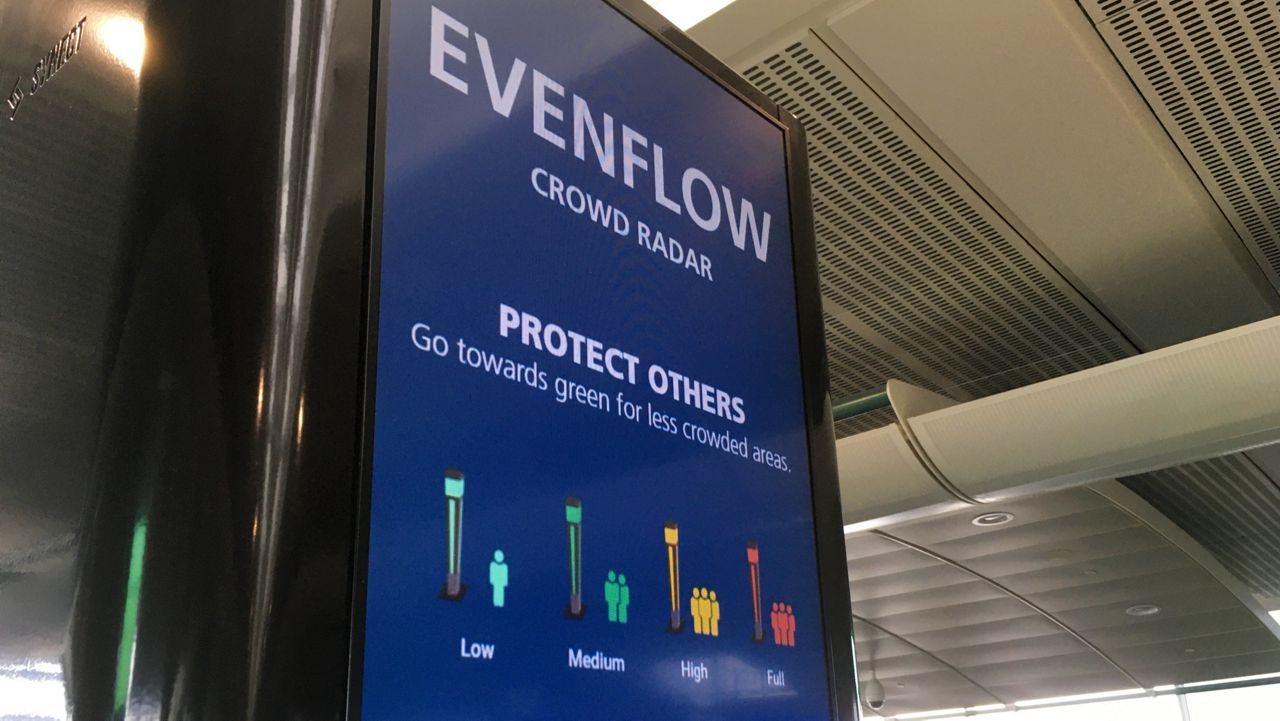ORLANDO, Fla. — There’s an air of innovation and new-normal at Orlando International.
What You Need To Know
- Orlando International deploys pilot program for crowd-monitoring system
- Developer says system aims to “reduce passenger anxiety” amid pandemic
- Orlando International is “world’s first” trial site for Evenflow Crowd Radar
The airport has deployed a pilot program for a crowd-detection system that it says monitors people density and allows travelers to make informed decisions about social distancing and about navigating potentially crowded areas.
It’s called Evenflow Crowd Radar, and it’s the product of Synect, a company with an Orlando office that trumpets itself as a creator of next-generation visual communications content.
Synect CEO Yahav Ran hailed Orlando International Airport as site of “the world’s first trial for the system.”
The Evenflow system comes as the coronavirus pandemic approaches its 10th month in the U.S. and as health officials continue to emphasize the importance of social distancing, among other safety measures.
The system has been in place at Southwest Airlines gates 101 through 109 since November 20, and the company says it will continue testing there for seven months. Officials said they chose those gates because Southwest represents the airport’s busiest airline based on departing passengers.
Yahav Ran, CEO of Synect, declares Orlando International as host to “the world’s first trial” of a system to monitor crowds in an effort “to reduce passenger anxiety and to make travel safer” during the pandemic. Check for our report later at https://t.co/YU8on0QNCj. #N13COVID19 pic.twitter.com/noZb8pPCqb
— Pete Reinwald, News 13 (@petereinwald) December 15, 2020
At a Tuesday news conference at Orlando International, Ran called the project “part of our visual communication efforts to reduce passenger anxiety and make travel safer at the airport and hopefully in the entire industry.”
He said the company started developing the system after the coronavirus hit the U.S. in March.
The system features lighted display panels and poles at and near airport gates. Color codes, from light green for low traffic to red for peak traffic, represent the degree of crowd density at each gate.
A traveler can look at the Evenflow panel at gate 101 to see crowd levels at succeeding gates. The traveler thereby can decide, without having to walk all the way to gate 109, whether to look for another area in which to wait for a flight.
Ran, the Synect CEO, demonstrated for reporters a smartphone app that the system includes.
Asked what happens to the system once the pandemic ends, Ran said he thinks travelers will find the system useful for the next couple of years, “just to relax... and give them tools to practice better health for themselves.”
Phil Brown, CEO of the Greater Orlando Aviation Authority, which operates Orlando International Airport, pointed out that the airport earlier partnered with Synect to create, throughout the airport, digital messages that offer travel, safety and other information.
The airport’s operations department compiled early data that shows “improved social distancing efforts,” Brown said.
Neither Brown nor Ran would say how much the system costs.
Brown said the aviation authority would decide after the pilot period whether to expand the Evenflow system throughout the airport.
“What we think is, rather than having a strike team or people patrolling trying to maintain social distance, if you give passengers information, they will use it to their best advantage,” Brown said. “So, what we hope to see is that as this develops, the science is backed up by the data.”
He said he hopes for “a system that we can ultimately deploy throughout the airport to provide passengers with information so that they can make decisions as to where they want to sit and stay as they make the journey through the airport.”



